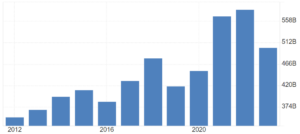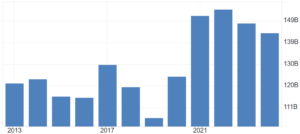
Trump tariffs will hit the US economy hard: Donald Trump has once again reached for his favourite economic weapon — tariffs. In his second term, Trump has announced sweeping tariff hikes on Chinese goods, bringing the total to a staggering 54%. Beijing wasted no time in hitting back. On Friday, China imposed a mirror 34% levy on all US goods and rolled out export curbs on critical rare-earth materials, escalating what is already the most severe phase of the US-China trade war. While Trump sells tariffs as a cure for America’s industrial woes, the reality is far less heroic: this is a high-stakes gamble that could end up isolating the US and bolstering China’s long-term economic autonomy.
While Trump sells tariffs as a panacea for America’s industrial decline, the empirical reality is far less flattering. These measures, economists warn, will hurt both China and the US — but not in equal measure. China’s economy will certainly feel the burn, but it’s the American consumer, business, and global standing that might suffer the most lasting damage.
READ I India braces for fallout as US tariffs redraw global trade map
Impact of Trump tariffs on China
Let’s begin with China. The 54% tariff regime could shave off as much as 2.4 percentage points from China’s GDP growth in 2025, while Goldman Sachs and BNP Paribas estimate a 1-2 percentage point hit. This could be significant, especially as China is just beginning to regain economic momentum after years of pandemic-related slowdown and structural imbalances.
But Beijing is not sitting idle. It is expected to roll out fiscal stimulus packages ranging from 1 to 2 trillion yuan, tapping into state-owned enterprise profits and issuing special sovereign bonds to bolster domestic demand. These funds will likely be funnelled into infrastructure, high-tech manufacturing, and consumer subsidies — precisely the kind of investment that makes China less vulnerable to future trade shocks. If anything, the tariffs might hasten China’s transition away from export dependence.
China’s exports to the US

US exports to China

And here lies the paradox. Trump tariffs, designed to hurt China, may end up accelerating the very economic transformation Beijing seeks — less reliance on American markets and more focus on internal consumption and regional supply chains.
China’s strategic response
Beijing’s response to Trump tariffs is as sweeping as it is strategic. Not only has it matched Washington’s 34% tariff hike on all US goods, it has also unleashed a barrage of targeted measures. China suspended key agricultural imports from US firms, including sorghum and poultry, and added 16 American defence-related entities to its export control list.
These moves hit precisely where Trump hopes to win political capital—among Midwest farmers and national security hawks. Meanwhile, Beijing has launched anti-dumping and monopoly investigations into US companies and slapped export curbs on rare earths essential to industries like electronics, aerospace, and defence. Far from flinching, China appears to be weaponizing its own trade leverage.
What’s more, the retaliation aligns with a clear geopolitical message. By using regulatory tools and the “unreliable entity” list, Beijing is signalling its capacity for calibrated escalation—not rash provocation. The rare-earth export restrictions, for instance, target materials like dysprosium and terbium, which the US needs but cannot easily substitute.
China is also drawing new lines in its diplomatic sand, penalising firms tied to arms sales to Taiwan while simultaneously reaching out to other trading partners alienated by Trump’s tariffs. As Chinese foreign ministry spokesperson Guo Jiakun put it, “Courtesy demands reciprocity.” For Xi Jinping, Trump’s aggression may have presented a rare opportunity — to retaliate loudly, yet with plausible restraint.
Tariff war may backfire on the US
Meanwhile, the US faces a different kind of blowback, one that is far more self-inflicted. Tariffs, after all, are taxes. And unlike a border wall or a catchy campaign slogan, they cost real money. American importers pay these levies upfront. Unsurprisingly, prices for consumer goods, from smartphones to sneakers, are set to rise. JPMorgan estimates these new tariffs could add 1-1.5% to inflation this year. In an economy still grappling with the aftershocks of monetary tightening, this is a dangerous gamble.
There’s also the employment angle. According to industry groups like IPC and the National Association of Wholesaler-Distributors, companies are already pausing hiring and investment decisions. Tariffs divert capital away from wage hikes and innovation and channel it into unproductive tax payments. If sustained, this could erode competitiveness, particularly in manufacturing, the very sector Trump claims to champion.
The bigger casualty, however, may be America’s soft power and global economic leadership. By slapping tariffs indiscriminately, including on key allies, Trump risks turning a targeted economic contest with China into a full-scale trade war with the world. The European Union, Japan, and South Korea are all considering retaliatory measures. Some have even floated restrictions on US financial institutions and tech firms.
What does this mean strategically? For one, it undermines America’s Indo-Pacific containment strategy. By alienating countries like India and Vietnam, potential balancers to Chinese influence, Trump may be pushing them closer to Beijing, not farther. If countries feel they are being punished regardless of alignment, the incentive to stick with Washington diminishes.
China busy building bridges
Geopolitically, the timing couldn’t be worse. China has already begun cozying up to estranged neighbours. Trade ministers from Japan and South Korea recently met with Chinese officials in Seoul for the first time in five years. Shared grievance against Trump’s tariffs may give Beijing the diplomatic opening it needs to drive a wedge into US-led coalitions.
Even within China, Trump tariffs may paradoxically strengthen Xi Jinping’s position. By framing the tariffs as external aggression, the Chinese leadership can stoke nationalism and deflect attention from domestic economic shortcomings.
In short, Trump tariffs may end up isolating the US, not China. It is one thing to compete with Beijing; it is quite another to push allies into China’s orbit by burning the very bridges that underpin American influence.
Zero-sum worldview
The ideological shift is also worth noting. Trump’s approach has little in common with the post-WWII trade order built on cooperation, trust, and mutual gain. Instead, it resurrects a 1930s-style world of beggar-thy-neighbour policies, where tariffs are wielded not as tools of diplomacy but as cudgels of coercion. This zero-sum worldview is not only economically damaging but geopolitically destabilising.
What’s more, Trump’s narrative is built on economic fallacies. The claim that China charges the US 67%, used to justify the 34% reciprocal tariff, is not based on tariff schedules but on the size of the trade deficit. Trade deficits, however, are not invoices; they reflect consumer choices, not tariff disparities. According to WTO data, China’s average applied tariff is 7.5% compared with the US’s 3.3%. The gap exists, yes, but it hardly justifies a 54% retaliatory levy.
If this is about fairness, then where is the industrial policy to back it up? Where are the investments in skills, green tech, or regional manufacturing hubs? Tariffs without a plan are just taxes with a press release. The Teamsters may cheer this as a pro-labour policy, but without support for wage growth or job retraining, the gains will be illusory.
Trump’s tariff tantrum might bring momentary applause in some rust-belt towns, but it risks triggering long-term decline. It burdens US consumers, distorts markets, weakens global alliances, and hands China both a scapegoat and a strategic opening. As in business, overleveraging your position without a long-term strategy may result in bankruptcy — this time, it is the American economy that’s at risk.
